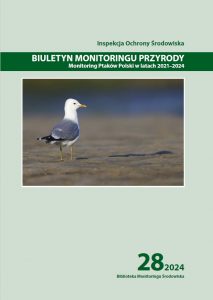Results of Bird Monitoring in Poland from 2021 to 2024
December 10, 2024
We are pleased to announce the release of the latest bulletin, Biuletyn Monitoringu Przyrody 28, summarising the results of work carried out within the framework of the Monitoring of Common Birds of Poland (MPP) in the breeding seasons 2021–2023 and migration-winter seasons 2021/22–2023/24. The publication contains results from 34 monitoring programs, including four new ones that began in 2021: the Common Urban Bird Survey, the Mountain Bird Survey, the Marsh Tern Survey, and the Meadow Waders Survey.

Tawny Pipit is one of the most rapidly disappearing, although once common, species in the country
Photo by Radoslaw Gwóźdź; Biuletyn Monitoringu Przyrody 28
Scope of surveys and results
Surveys conducted within 28 programs devoted to breeding birds allowed us to analyse the abundance of 182 nesting species in Poland. In turn, six programs carried out from autumn to spring covered 38 migratory and wintering species.
The results indicate stability in the abundance of 19 monitored breeding species, population increases in 44 species and declines in 35. The Green Woodpecker showed the most dynamic increase, while the Lapwing showed the most significant decline. Trend analyses revealed steadily declining farmland and wetland birds, with a simultaneous increase in the abundance of common forest birds.

The European Roller is now on the brink of extinction, with no more than five pairs currently nesting in the country
Photo: Michał Rycak; Biuletyn Monitoringu Przyrody 28
Additional topics covered in the publication
The bulletin is not only a detailed discussion of the monitoring programs´ results but also interesting articles on issues related to the monitored species. Readers can learn more about the urbanisation of the Common Gull, the impact of avian influenza on gull and tern colonies, the role of the Hooded Crow as a keystone species, and the deteriorating situation of the Roller in Poland.
Attractive form and rich graphic design
The publication is enriched with numerous illustrations, including 224 charts, eight tables, 12 maps and 50 photographs, which facilitate understanding of the data presented and make the reading even more enjoyable. All captions are also given in English.

We invite you to read the concise English summary and discover the latest information on the condition of bird populations in Poland!
The electronic version of the Biuletyn Monitoringu Przyrody 28 is available here.

Monitoring of Birds of Poland is conducted on behalf of the Chief Inspectorate for Environmental Protection thanks to funding from the National Fund for Environmental Protection and Water Management.